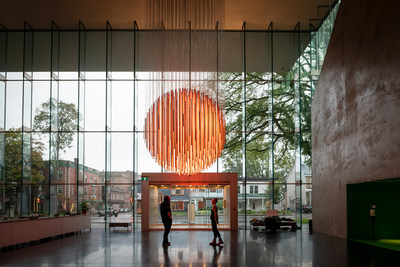New Exhibition
September 27, 2018 to February 24, 2019
QUÉBEC CITY, Sept. 26, 2018 /CNW Telbec/ - After travelling to Germany, Australia, England and South Korea, Rafael Lozano-Hemmer's Solar Equation will be making its Canadian premiere at the Musée national des beaux-arts du Québec (MNBAQ).



This spectacular installation will shine like a thousand suns—or at least one Sun—in the Pierre Lassonde Pavilion's Grand Hall from September 27, 2018 to February 24, 2019. For the Museum, this exhibit is a way to remain connected to the present by encouraging reflection on its ecological and philosophical nature, as well as the future of our planet.
This massive installation is a scale model of our Sun, 400 million times smaller than the original. Solar Equation is made up of LEDs suspended in the public area at the entrance to the Museum. It uses data captured by NASA's solar observatory to recreate the surface of the Sun. Fluid dynamic equations ensure that the light turbulence on display is never repeated.
Visitors can interact with the installation by choosing one of 11 solar seasons. They can also observe the constantly changing movement and learn more about this incredible natural phenomenon, which was only recently discovered through advances in astronomical research.
The size of the installation and the boldness of the project make it an incomparable experience. Solar Equation has the power to move us and unite us. What's more, it makes us think about climate change, the importance of solar energy as a counter-measure and our relationship with the world around us. A trip through the Pierre Lassonde Pavilion's Grand Hall is a must to take in this incredible project.
Technology serving art: technical details
Solar Equation: 3 metres in diameter, weighs nearly 1,500 kg
LED Battens, aluminium and wood framework, computer running solar turbulence equations, OpenFrameworks and d3 programming
A spherical volumetric display simulates the turbulence, flares and spots visible at the surface of the sun. The piece is animated by fluid dynamic equations like reaction diffusion, Navier-Stokes, Perlin noise and fractal flames, together with the latest imagery from NASA's SDO and SOHO observatories. The content is not a video loop but a live simulation, so the content never repeats itself.
The sphere consists of 25,580 LED lights on 342 battens that are arranged according to Fermat's equations that describe plant phyllotaxis, so the sphere does not have vanishing points.
Solar Equation is an iconic chandelier, constantly changing, inspired by the geometric immersive work of Latin American artists such as Jesús Rafael Soto, Carlos Cruz-Diez and Julio Le Parc on the one hand and by scientists such as Pierre de Fermat, Oleg Losev and Shuji Nakamura on the other.
Solar Equation is a co-production by APMA (Seoul) with the Musée National des Beaux Arts in Québec.
Biography of Rafael Lozano-Hemmer
Rafael Lozano-Hemmer was born in Mexico City in 1967. In 1989, he received a B.Sc. in Physical Chemistry from Concordia University in Montréal, Canada. He was rapidly drawn to electronic arts, leading him to develop an artistic practice based on "relational architecture", which focuses on "hijacking" familiar urban environments by offering viewers a new way of looking at them. He uses technology to fulfil his desire to create social experiences where performance and interaction combine. To Lozano-Hemmer, there is no art without an audience. Going against the elitist representation of power, his large-scale installations are "antimonuments for alien agency" that are inspired by phantasmagoria, carnival and animatronics. On a smaller scale, his installations and other digital creations explore the themes of perception and surveillance.
In 2007, Lozano-Hemmer was the first artist to officially represent Mexico at the Venice Biennale with a solo exhibition at the Van Axel Palace. He has also shown at biennials in Sydney, Liverpool, Shanghai, Istanbul, Seville, Seoul, Havana, New Orleans, Singapore and Moscow. His work has been commissioned for events like the Triennale québécoise in Montréal in 2011, the Millennium Celebrations in Mexico, the UN World Summit of Cities in Lyon, the Expansion of the European Union summit in Dublin, the memorial for the Tlatelolco Student Massacre in Mexico City, the 50th anniversary of the Guggenheim Museum in New York and the 2010 Winter Olympics in Vancouver.
He also has works in collections at multiple institutions such as the MoMA, the Tate Modern and the Guggenheim. He has received two BAFTA Awards for Interactive Art in London, a Golden Nica at the Austrian Prix Ars Electronica, a Rave Award from Wired Magazine in Lyon and an International Bauhaus Award in Dessau. In June 2016, Rafael Lozano-Hemmer was named a Compagnon des arts et des lettres du Québec (Companion of Arts and Literature in Québec) by the Conseil des arts et lettres du Québec.
Credits
Solar Equation is a co-production by APMA (Seoul) with the Musée National des Beaux Arts in Québec. We would like to thank the Canada Council for its support. Last year, the Canada Council invested $153 million to bring art to the lives of Canadians from coast to coast.
Project Manager
Annie Gauthier
Director of Collections and Research, MNBAQ
Coordinator
Mylène Renaud
Exhibition Project Manager, MNBAQ
Graphic Design
Marie-France Grondin
Designer, MNBAQ
Operations Manager
Yasmée Faucher
Chief of Operations, MNBAQ
Claude Lapouble
Chief of Material Resources, MNBAQ
Digital mediation
Anne-Josée Lacombe
Coordinator of Digital Mediation, MNBA Q
The Musée national des beaux-arts du Québec is a state corporation funded by the Gouvernement du Québec.
Solar Equation
Grand hall du pavillon Pierre Lassonde du MNBAQ
September 27, 2018 to Februay 24, 2019
SOURCE Musée national des beaux-arts du Québec

418 643-2150 or 1 866 220-2150, mnbaq.org
Share this article